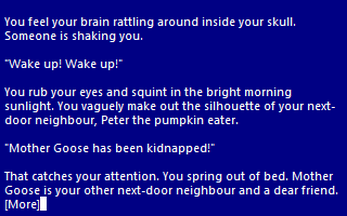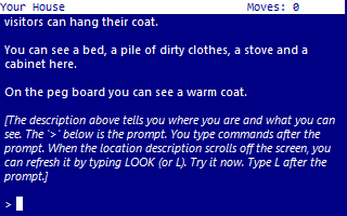
Who Kidnapped Mother Goose? (TALP)
Introduction
You feel your brain rattling around inside your head. Someone is shaking you.
"Wake up! Wake up!"
You rub your eyes and squint in the bright morning sunlight. You vaguely make out the silhouette of your next-door neighbour, Peter the pumpkin eater.
"Mother Goose has been kidnapped!"
That catches your attention. You spring out of bed. Mother Goose is your other next-door neighbour and a dear friend. Once Peter sees that you're out of bed, he quickly loses interest in the emergency and goes to tend to his vegetable garden. You, however, must rescue Mother Goose!
Instructions
This is a traditional text adventure that was written for Text Adventure Literacy Jam 2024, 1 March to 30 April 2024. See the jam page for the competition rules.
A text adventure is a form of computer game that presents you with a story. You take on the role of the main character in the story and control that character's actions. The story has a goal and you will need to solve puzzles in order to achieve that goal. The computer tells you where you are, what you can see and what's happening around you. You can then move around, examine the things you find and manipulate those things by telling the computer what to do using simple English commands.
Commands consist of a verb phrase, optionally followed by a noun phrase. Most commands can be abbreviated to a verb followed by a noun. For example, GET THE WARM COAT can be abbreviated to GET COAT.
If the verb is followed by a preposition, this may alter its meaning. For example, GET BED will attempt to pick up the bed, but GET IN BED will attempt to climb into it.
In some cases, the verb phrase and first noun phrase may be followed by a second noun phrase. The two noun phrases are usually separated by a preposition. For example, HIT MAN will attempt to hit the man with your hands (as you didn't specify a second noun phrase), but HIT MAN WITH ROCK will attempt to hit the man with the rock. If you only use a verb and a noun, the game will generally tell you if it needs an extra phrase or implicitly try to deduce what is needed for the second phrase.
Don't panic! It's not as complicated as it sounds. Just use simple English sentences starting with a verb and it will all feel quite natural.
Movement
To move around, use commands like GO NORTH and GO SOUTH. You can move in any of the four cardinal compass directions, as well as UP and DOWN. To save typing, movement commands can be abbreviated to N, S, E, W, U and D. You can sometimes use other movement commands such as IN, OUT, ENTER, EXIT or CLIMB. These will be reasonably obvious when the time comes.
Examining things
Make sure you EXAMINE everything you come across, even insignificant things like scenery and objects mentioned in room descriptions, as subtle hints and clues are scattered everywhere. To save typing, EXAMINE can be abbreviated to X. For example, EXAMINE WINDOW can be abbreviated to X WINDOW.
You can also try your other senses when it seems appropriate, e.g. SMELL, TOUCH or LISTEN. Unlike EXAMINE, these actions aren't necessary to solve any puzzles.
Manipulating objects
Apart from examining things, most of your time will be spent manipulating objects. Use commands like GET or TAKE to pick up an object, e.g. GET COAT. Use commands like DROP or DISCARD to drop an object, e.g. DROP COAT. Use WEAR to wear something, e.g. WEAR COAT. Use REMOVE to remove something that is already worn, e.g. REMOVE COAT.
To see what you're currently carrying and wearing, use INVENTORY (or I). As you're not a pack horse, you can only carry ten items at a time.
There are many other verbs that can be used to manipulate objects. These will be fairly obvious when the time comes. Common verbs include OPEN, CLOSE, EAT, DRINK, READ, BUY and so on. Use PUT, PLACE or INSERT to put objects into containers or on supporters, e.g. PUT COAT ON PEG.
Communicating with characters
You will encounter a lot of characters in this game. When you first meet new characters, in addition to examining them, you should try talking to them, e.g. TALK TO BARTENDER. To get further information from them, try asking them about something relevant, e.g. ASK BARTENDER ABOUT TAVERN WENCH. This game is partially about gathering information, so you will need to ask lots of characters about lots of things. You can also try giving them something, e.g. GIVE RAT TO WENCH.
Advanced features
You can use IT or THEM to refer to the noun used in the previous command, e.g. EXAMINE CABINET, OPEN IT (for a singular object) or EXAMINE CLOTHES, SEARCH THEM (for plural objects). You can also use HIM and HER to refer to male and female characters used in the previous command, e.g. ASK BARTENDER ABOUT WENCH, ASK HIM ABOUT HIMSELF or EXAMINE WENCH, TALK TO HER.
You can refer to multiple objects by separating the objects with AND, e.g. GET TRAP AND CHEESE. Using IT and THEM in the next command will only refer to the last of those objects, e.g. EXAMINE IT will refer to the cheese.
You can use ALL to refer to all the appropriate objects with GET and DROP, e.g. GET ALL to get everything in the current location, GET ALL FROM TABLE to get everything on the table, DROP ALL to drop everything you're holding.
When using ALL, you can use EXCEPT or BUT to exclude some objects, e.g. DROP ALL EXCEPT COAT.
Finally, you can enter multiple commands on the same line by separating them with a period, e.g. EXAMINE CABINET. OPEN IT.
Scoring
There is no score in this game. Your objective is to find and rescue Mother Goose.
Other commands
Use LOOK (or L) to refresh the display.
Use VERSION to get the game version. Use ABOUT or INFO to get background information and credits for the game. Use CREDITS to get the credits only.
Use SAVE to save your progress. Use RESTORE to restore a saved game.
Use UNDO to undo the last move. This is handy if you change your mind or make a mistake. You shouldn't be able to get into an unwinnable situation in this game, but it is possible to get killed near the end, so save the game when it looks like you're about to get into a dangerous situation. (UNDO is not available with the z3 version of the game.)
Use AGAIN (or G) to repeat the last command.
Use WAIT (or Z) to do nothing apart from pass the time.
Use HELP to get a brief reminder of how to play the game or HINT to get a context-sensitive hint related to the current location. (This will be added later.)
Use RESTART to restart the game from the beginning. Use QUIT (or Q) to quit without restarting. (Don't use QUIT with the online version of the game, as the game will appear to be locked up. In this case, press the Back button in your browser.)
Most importantly, have fun and enjoy the game. If you're familiar with the Mother Goose nursery rhymes, then this game should refresh some happy childhood memories.
Keyboard shortcuts
Some interpreters have keyboard shortcuts. If you are using an interpreter on a computer with a conventional keyboard, most will allow you to press the up and down arrow keys to cycle through your past commands. This is handy if you want to repeat the previous command or correct a typo.
Playing the game
There are two ways to play the game.
Click the Run game button (above) to play the game in a browser. (Coming later.)
Download the z5 file and play the game using a z-code interpreter (see below).
Finding a z-code interpreter
There are a variety of z-code interpreters for all the major platforms, as well as many minor and retro platforms. There are far too many to list here. The best source of downloads is probably the Interactive Fiction Archive. Navigate to infocom/interpreters for z-code interpreters and interpreters-multi for interpreters that interpret both z-code games and other formats.
Common z-code interpreters
Android: I recommend Hunky Punk from Google Play. (There are others, as well.)
iOS: I recommend Frotz from the Apple App Store. (There are others, as well.)
Linux: See the links above.
Mac: See the links above.
Windows: I recommend Windows Frotz from the infocom/interpreters link above. (There are others, as well.)
Credits
Inform 6 compiler, language and library originally written by Graham Nelson and now maintained by David Griffith, David Kinder, Andrew Plotkin et al.
PunyInform library written by Johan Berntsson and Fredrik Ramsberg based on the Inform 6 library.
ZAbbrevMaker written by Henrik Åsman.
Parchment interpreter written by Dannii Willis et al.
Concept by Garry Francis and Michael Berryman.
Game design and coding by Garry Francis.
Testing by Darren & Jasper, Deborah Sherwood, Gianluca Girelli, Hidnook, Jade J Aincioa, John H Doolittle, Leon Lin and manonamora.
| Updated | 23 days ago |
| Status | Released |
| Platforms | HTML5, Windows, macOS, Linux, Android |
| Rating | Rated 5.0 out of 5 stars (1 total ratings) |
| Author | Garry Francis |
| Genre | Interactive Fiction |
| Tags | inform-6, nursery-rhyme, parser, punyinform, Retro, talp, text-adventure, Text based, Tutorial |
| Average session | About an hour |
| Languages | English |
| Inputs | Keyboard |




Comments
Log in with itch.io to leave a comment.
Very cute game! I loved the subtle humor used in describing grown-up versions of nursery rhyme characters, including the easter eggs such as with Peter. The game feels easy to figure out and play and the writing is engaging and informative.
It took me 601 moves to rescue Mother Goose. I got a bit stuck with waking up Willy (didn't search enough and was trying screaming and shouting) and making the children shoo (was trying to dance and play with them). Also wasted a number of turns on typos/invalid commands (eg ex instead of x, coming from MUDs) and blank command entries (again, a MUD holdover where text isn't deleted at entry).
Overall, I found it very charming!
Thank you for the kind words. It was a lot of fun to write, so I'm glad you liked it.
The adventure is very well-written and it’s interesting to discover more about your neighbors.✨
Do not judge a book by its cover, the story is not exactly what I was expecting by the cover art!🎃
That's true, but I didn't want to reveal too much about the characters until people have played the game. Let's just say that the game is inspired by the Mother Goose nursery rhymes, but expect some surprises along the way.